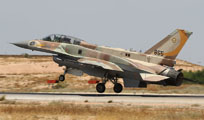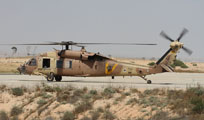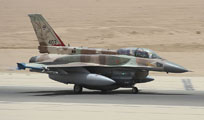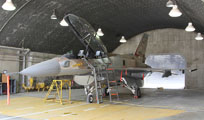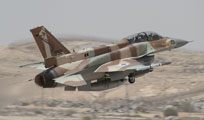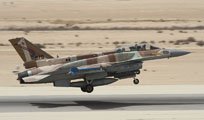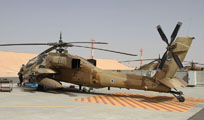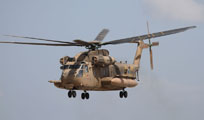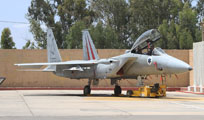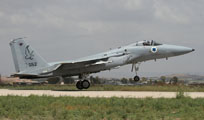 |
|
Nello lo scorso mese di maggio, l’inviato di www.giorgiociarini.it ha avuto l’eccezionale opportunità di partecipare and un Press Tour organizzato dalla Heyl Ha'Avir (Israeli Air Force), con una serie di tre visite ad altrettante basi operative : Hatzerim, Tel Nof e Ramon.
Durante queste giornate sono state effettuate normali operazioni di volo che hanno dimostrato la prontezza operativa dei reparti ivi schierati.
Grazie alla gradita disponibilità dei PAO che hanno gestito questo evento, è stata data la possibilità, ai reporter presenti, di effettuare eccellenti riprese fotografiche, una prassi non comune per l’alto livello di sicurezza di cui si è sempre circondata questa forza armata.
Sulla base di Hatzerim sono presenti sei unità operative:
- 69 Sq. equipaggiato con F-15I (Ra’am);
- 102 Sq. equipaggiato con A-4N / TA 4H / TA 4J (AhitM);
- 107 Sq. equipaggiato con F-16I (Sufa);
- 123 Sq. equipaggiato con S-70A / UH 60A (Yanshuf 3);
- FTS (Flight Training School) equipaggiata con G-102A (Snunit) / Tsukit / T-6A (Efroni) / OH-58B (Saifan) / AH-1F (Tsefa C);
- Aerobatic Team equipaggiato con Tsukit.
Sulla base di Ramon sono presenti cinque unità operative:
- 113 Sq. equipaggiato con AH-64D (Saraf);
- 119 Sq. equipaggiato con F-16I (Sufa);
- 190 Sq. equipaggiato con AH-64A (Peten);
- 201 Sq. equipaggiato con F-16I (Sufa);
- 253 Sq. equipaggiato con F-16I (Sufa).
Sulla basi di Tel Nof sono presenti sette unità operative:
- 106 Sq. equipaggiato con F-15B / F-15C / F-15D (Baz);
- 114 Sq. equipaggiato con CH-53 (Yas’ur);
- 118 Sq. equipaggiato con CH-53 (Yas’ur);
- 133 Sq. equipaggiato con F-15A / F-15B / F-15D (Baz);
- 210 Sq. equipaggiato con Heron TP (Eitan);
- Unit 269 equipaggiato con CH-53 (Yas’ur) unità conosciuta anche come Air Force Aeromedical Rescue and Evacuation Unit;
- FTC (Flight Test Center) ha in carico vari velivoli F-16A / F-16B / F-16C / F-16D / F-16I / F-15I / Tzukit.
|
 |
Hatzerim si trova nel sud di Israele a ovest di Beersheba, nel deserto del Negev. Come Beersheba (la "capitale del Negev") è cresciuta, si è espansa fino ai bordi della base aerea stessa.
Questa base aerea è stata costruita nel 1960, ma solo nel 1966 vengono svolte le prime attività da parte della Forza Aerea. La struttura dispone di un totale di quattro piste, la cui lunghezza varia da 1.830 a 2.750 metri. Le unità operative utilizzano solitamente le due piste sud mentre l’Accademia di volo utilizza la coppia di piste poste a nord-ovest.
Nonostante sia una base operativa con vari gruppi di volo, Hatzerim ospita anche l'Air Force Museum, il museo è collocato nella zona nord-ovest, fondato nel 1977 e stato aperto al pubblico nel giugno 1991, conta più di un centinaio di velivoli in mostra.
Uno dei reparti più prestigiosi presenti ad Hatzerim è l'Accademia del Volo della IAF, la scuola ha iniziato l’attivtà di volo nel 1950, all’inizio sul campo di Sirkin vicino Petach Tikva, da Sirkin la scuola si è trasferita sulla base aerea di Tel Nof, ed infine approda alla sua dislocazione attuale di Hatzerim. La missione principale della Flight Academy è quella di qualificare gli equipaggi destinata alla Forza Armata. Ad Hatzerim è basata anche la Pattuglia Acrobatica israeliana, equipaggiata con quattro “Tsukit” denominazione locale dell’addestratore di produzione francese CM 170 Fouga Magister (Aerospatiale).
Il 19 gennaio del 1998 sono arrivati ad Hatzerim i primi due, di un totale di 25, Boeing F 15I Ra’am. |
|
|
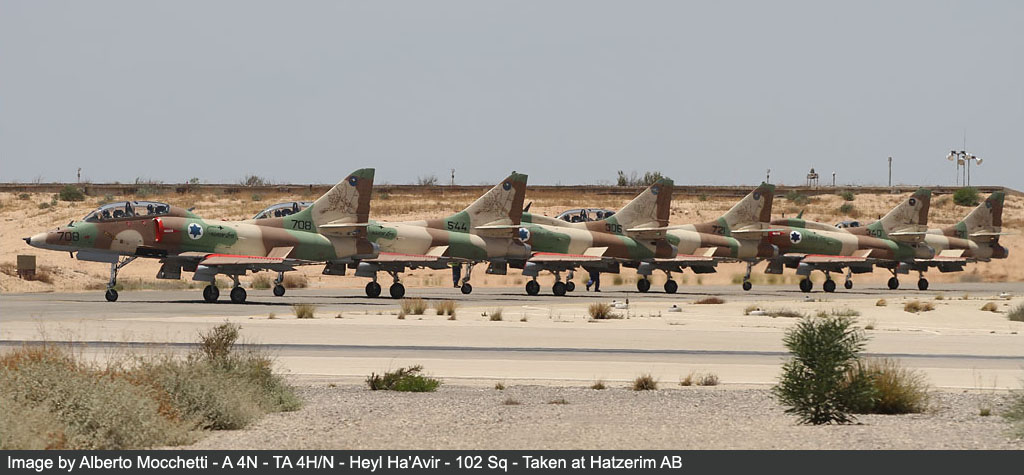 |
|
|
 |
Nel 1972 l’Aeronautica Militare decise di aprire una sesta base operativa collocata nel Sinai, all’inizio era conosciuta come Eitam, successivamente venne sostituito la denominazione nell’attuale Ramon Air Base. A seguito degli accordi di Camp David, e il ritorno della penisola del Sinai all’Egitto, gli americani hanno ricostruito la base nel deserto del Negev centrale, vicino alla piccola città di Mitzpe Ramon. La costruzione della base è stata completata il 24 aprile 1982, ed è stata inaugurata il 19 maggio dello stesso anno.
Nel 1982 il "Negev" Squadron, equipaggiato con F 16, si trasferisce a Ramon. Questo reparto aveva partecipato all'operazione "Litani", tra i membri fondatori, il colonnello Ilan Ramon, che aveva partecipato al bombardamento del centro nucleare iracheno. Nel 1982 il Reparto ha partecipato alla prima guerra del Libano, abbattendo cinque aerei nemici; nel 2003 è stato il primo reparto nella IAF ad operare il nuovissimo F 16I Sufa, i primi due dei quali atterrarono sulla base nel 2004.
Nel 1984 il "Magic Touch" Squadron, che ha operato gli elicotteri MD 500 Defender, venne spostato da Palmahim a Ramon per essere trasferito nel 1990 a Ramat David, il “Magic Touch” torna di nuovo a Ramon nel 1995, questa volta con in dotazione l’AH 64A Apache. Quest’ultimo reparto ha svolto un ruolo importante nella prima guerra del Libano, dopo di che ha operato intensamente in territorio libanese, in particolare nell'ambito delle operazioni "Accountability" e "Grapes of Wrath".
Nel 1990 lo Squadron "Wasp" viene formalmente costituito sulla base di Ramon, il 3 aprile 2005 gli vengono consegnati i primi tre elicotteri Apache AH 64D Longbow, tra l’altro i primi a raggiungere Israele. Questi elicotteri hanno partecipato all'operazione "Change of Direction" ed alla seconda guerra del Libano.
Nel 2004 viene ricostituito sulla base aerea lo Squadron "Bat" con in dotazione il cacciabombardiere F 16I. Il "Bat" aveva avuto in dotazione il caccia supersonico francese Mirage, con questi velivoli prese parte alla guerra dello Yom Kippur, realizzando 346 missioni di attacco ed abbattendo 23 aerei nemici (il più alto risultato raggiunto da qualsiasi reparto della IAF), il reparto ha assunto un ruolo importante anche durante l'operazione "Cast Lead". |
|
|
 |
Tel Nof (troppo spesso erroneamente chiamata Tel Nov) Air Base è collocata a diversi chilometri a sud est di Tel Aviv (nel Negev vicino a Rehovot). Tre delle basi dell'Israeli Air Force: Ramat David, Tel Nof e Nevatim sono tutte situate in prossimità delle linee del cessate il fuoco precedenti al 1967, conosciuta anche come la "linea verde". La struttura dispone di tre piste, due sono di 2.750 metri di lunghezza, mentre la terza è di 1.830 metri.
La base aerea è il principale centro operativo e di formazione per tutte le forze paracadutiste dell'esercito israeliano, così come la sede dell’Unità 699 (Aka Maslul), dell’Israeli Defence Force Airborne Combat Search And Rescue (CSAR) (Forza Aerea di Difesa, Combattimento Ricerca e Salvataggio), di una unità sotto il comando della Special Air Force (KAHAM), poi troviamo l'ORT Israele, infine l'Amministrazione per la Ricerca e lo Sviluppo e Formazione che opera per la scuola e per l’industria aeronautica.
Tel Nof è stata in passato sede del Flight Academy, l’Accademia Aeronautica della Forza Aerea, ora collocata sulla base aerea di Hatzerim. |
|
|
| Oltre ai reparti operativi, Tel Nof ospita il MANAT (Mer-kaz Nisu-yei Ti-sa/Center o Flight Test / FTC), il MANAT è un Reparto Sperimentale che si occupa della valutazione di aeromobili e dei sistemi d'arma che verranno acquisiti dalla Forza Aerea, questa unità è anche denominata come Squadron 601. Tel Nof in passato ha rappresentato un nodo cruciale per la difesa di Israele, infatti già nel maggio del 1948 Israele ha acquistato un certo numero di velivoli Messerschmitt costruiti in Cecoslovacchia, gli aerei sono stati smontati, trasportati in Israele durante la notte, e segretamente riassemblati a Ekron (poi divenuta Tel Nof AB). Il 29 maggio 1948 una colonna egiziana, composta da circa 500 veicoli blindati e cannoni, attraversò Kibbutz Nitzanim in ascesa verso il nord; lo Stato Maggiore Generale della Israel Defence Force decise di colpire duramente la colonna egiziana che avanzava, impiegando per la prima volta aeroplani provenienti da Ekron. Il 29 ottobre, la Campagna del Sinai del 1956 iniziò con sedici aviolanci effettuati da alcuni Dakota decollati dalla pista di Tel Nof. A bordo si trovavano 495 paracadutisti del Battaglione 890 comandato dal maggiore Rafael Eitan (destinato a diventare Capo di Stato Maggiore dell’IAF), i parà raggiunsero il loro obiettivo in prossimità dell'ingresso al Passo Mitla, dopo due ore di marcia prepararono una pista di atterraggio di emergenza ed una zona di atterraggio per le truppe aviotrasportate. Durante la notte vennero trasportate forze supplementari dotate di Cannoni e Jeep questa volta lanciate da un Dakota e da quattro Nord 2501 Noratlas. |
|
|
Foto e testo di Alberto Mocchetti
Maggio 2012 |
|
English translation by Dario Cocco
During last month of May, the correspondent of www.giorgiociarini.it had the unique opportunity to participate to a press tour organized by the Heyl Ha'Avir (Israeli Air Force), with a series of three visits to as many operational bases: Hatzerim, Tel Nof and Ramon.
During these days normal flight operations were carried out which have demonstrated the readiness of the units deployed there.
Thanks to the welcome availability of PAO who managed this event, the reporters present were given the opportunity of making excellent photographic shoots, an unusual practice for the high level of security which has always surrounded this armed force.
At Hatzerim air base are present six operative units:
- 69 Sq. equipped with F-15I (Ra’am);
- 102 Sq. equipped with A-4N / TA 4H / TA 4J (AhitM);
- 107 Sq. equipped with F-16I (Sufa);
- 123 Sq. equipped with S-70A / UH 60A (Yanshuf 3);
- FTS (Flight Training School) equipped with
G-102A (Snunit) / Tsukit / T-6A (Efroni) / OH-58B (Saifan) / AH-1F (Tsefa C);
- Aerobatic Team equipped with Tsukit.
At Ramon Hatzerim air base are present five operative units:
- 113 Sq. equipped with AH-64D (Saraf);
- 119 Sq. equipped with F-16I (Sufa);
- 190 Sq. equipped with AH-64A (Peten);
- 201 Sq. equipped with F-16I (Sufa);
- 253 Sq. equipped with F-16I (Sufa).
At Tel Nof Hatzerim air base are present seven operative units:
- 106 Sq. equipped with F-15B / F-15C / F-15D (Baz);
- 114 Sq. equipped with CH-53 (Yas’ur);
- 118 Sq. equipped with CH-53 (Yas’ur);
- 133 Sq. equipped with F-15A / F-15B / F-15D (Baz);
- 210 Sq. equipaggiato con Heron TP (Eitan);
- Unit 269 equipped with CH-53 (Yas’ur) unit also known as Air Force Aeromedical Rescue and Evacuation Unit;
- FTC (Flight Test Center)
which is equipped with various aircraft F-16A / F-16B / F-16C / F-16D / F-16I / F-15I / Tzukit.
Hatzerim Air Base
Hatzerim is located in the South of Israel West of Beersheba in the Negev desert. While Beersheba (the "Capital of the Negev") has grown, it has expanded to the edge of the air base itself.
This air base was built in 1960, but not until in 1966 the first activities were carried out by the Air Force. The facility has a total of four runways, ranging in length from 1830 to 2750 meters. The operational units typically use two southern runways while the Flight Academy uses the north-west pair of runways.
Despite being an operational base with various squadrons, Hatzerim also houses the Air Force Museum, located in the north-west part, which was established in 1977 and opened to the public in June 1991. It has more than a hundred aircraft on display.
One of the most prestigious departments present at Hatzerim is the IAF Flight Academy; the school began its flight activity in 1950, at a camp near Petach Tikva Sirkin. The school moved from Sirkin to Tel Nof airbase, and finally arrived at its current dislocation at Hatzerim. The primary mission of the Flight Academy is to qualify crews employed by the armed forces. At Hatzerim is also based Aerobatic Israel, equipped with four "Tsukit" the local name of the french built trainer Fouga Magister CM 170 (Aerospatiale).
On January 19th 1998 the first two, from a total of 25, Boeing F 15I Ra'am arrived at Hatzerim.
Ramon Air Base
In 1972 the Air Force decided to open a sixth operational base located in the Sinai, initially known as Eitam, later changed its name as Ramon Air Base. Following the Camp David Accords, and the return of the Sinai Peninsula to Egypt, the Americans have rebuilt the base in the central Negev desert, near the small town of Mitzpe Ramon. The construction of the base was completed April 24th, 1982, and was inaugurated on May 19th of that year.
In 1982, the "Negev" Squadron, equipped with F-16, moved to Ramon. This detatchement participated in "Operation Litani", one of its founding members being Colonel Ilan Ramon, who had taken part in the bombing of the Iraqi nuclear center. In 1982 the Department participated in the first Lebanon War, tearing down five enemy planes. In 2003 was the first department in the IAF to operate the new F 16I Sufa, the first two of which landed on the base in 2004.
In 1984, the "Magic Touch" Squadron, which operated MD 500 Defender helicopters, was moved from Palmahim to Ramon to be transferred in 1990 to Ramat David. The "Magic Touch" came back again to Ramon in 1995, this time equipped with AH 64A Apaches. This department has played an important role in the first Lebanon War, after which it worked intensely on Lebanese territory, in particular as part of "Accountability" and "Grapes of Wrath" operations.
In 1990 the "Wasp" Squadron was formally set up at Ramon airbase; on April 3rd 2005 the first three AH 64D Longbow Apache helicopters were supplied, the first of the type to reach Israel. These helicopters participated to the operation "Change of Direction" and to the second Lebanon war.
In 2004 on the airbase the Squadron "Bat" was rebuilt equipped this time with F 16I fighters. The "Bat" was formerly equipped with French Mirage supersonic fighters, with these aircraft took part in the Yom Kippur War, completing 346 attack missions and bringing down 23 enemy planes (the highest result achieved by any department of the IAF). This Department has assumed an important role during Operation "Cast Lead".
Tel Nof Air Base
Tel Nof (too often erroneously called Tel Nov) Air Base is located several miles southeast of Tel Aviv (near Rehovot in the Negev). Three of the Israeli Air Force bases, Ramat David, Tel Nof and Nevatim are all located along the lines of the ceasefire prior to 1967, also known as the "green line". This facility has three runways, two of 2,750 meters in length, while the third is of 1,830 meters.
The air base is the main center of operations and training for all the forces of the Israeli army paratroopers, as well as the headquarters of Unit 699 (Aka Maslul), the Israeli Defence Force Airborne Combat Search And Rescue (CSAR) (Air Force Defense, Combat Search and Rescue), an unit under the command of the Special Air Force (KAHAM), then we find the ORT Israel, then the Administration for Research and Development and Training that works for the school and for the aviation industry
Tel Nof was once the seat of the Flight Academy, the Air Force Academy Air Force, now located on the Hatzerim Air Force Base.
In addition to operating squadrons, it is home of the Tel Nof MANAT (Mer-kaz Nisu-yei Ti-sa/Center or Flight Test / FTC), the MANAT is a Test Unit that deals with the evaluation of aircraft and weapon systems that will be acquired by the Air Force, this unit is also known as Squadron 601. Tel Nof in the past has been a major issue for the defense of Israel, in fact, already in May 1948, Israel has acquired a number of Messerschmitt aircraft built in Czechoslovakia, the planes were dismantled, transported to Israel during the night, and secretly reassembled at Ekron (later to become Tel Nof AB).
On May 29th 1948 an Egyptian column, consisting of about 500 armored vehicles and artillery, crossed Kibbutz Nitzanim heading northbound, the General Staff of the Israel Defence Force decided to hit hard the advancing Egyptian column, using for the first time airplanes from Ekron. On October 29th, the Sinai Campaign of 1956 began with sixteen paratroops launches made by some Dakotas which took off from the runway at Tel Nof. On board there were 495 paratroopers of the 890th Battalion commanded by Major Rafael Eitan (destined to become Chief of Staff of the IAF), the paratroopers reached their targets near the entrance of the Mitla Pass, within two hours they set up a runway for emergency landings and a landing zone for the paratroops. During the night additional forces equipped with cannons and Jeeps were launched from a Dakota and four Nord 2501 Noratlas.
|
Images and text by Alberto Mocchetti
May 2012 |
|


























